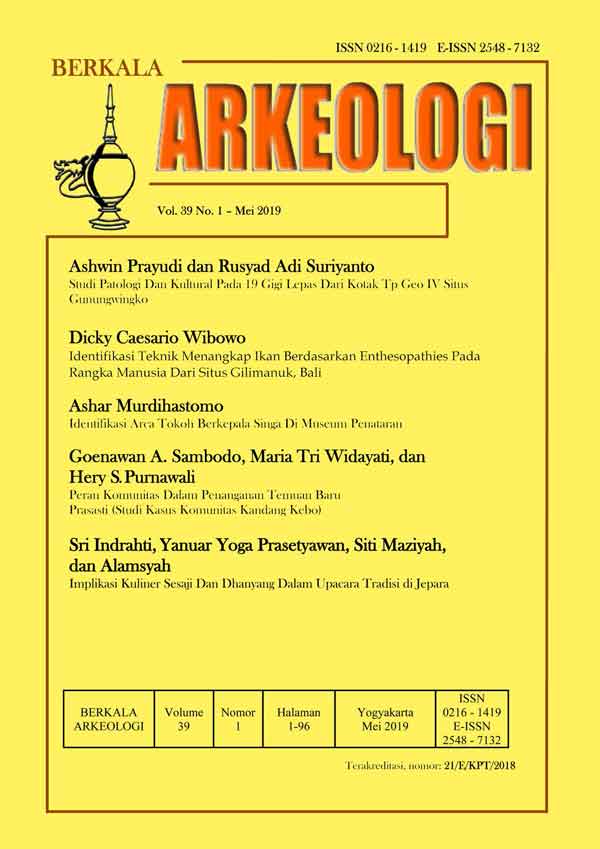IDENTIFIKASI TEKNIK MENANGKAP IKAN BERDASARKAN ENTHESOPATHIES PADA RANGKA MANUSIA DARI SITUS GILIMANUK, BALI
Main Article Content
Abstract
Due to its location in Gilimanuk Bay and its findings, Gilimanuk site stated for having fishers as subsistence strategy. This research uses pathological condition called enthesopathies as the primary data to induce fishing techniques as part of their daily activities. Identification enthesopathies follows procedure proposed by Hawkey & Merbs and Mariotti. Result shows only two specific techniques which can be identified through pathological condition. Those techniques are fishing with stick and spearing methods. Based on pathological conditions, early fisher’s community from Gilimanuk only developed shallow water fishing techniques. Absence of other fishing techniques indicates by artefacts and induced from enthesopathies might lead to early assumption about natural resources are widely available and easy to procure in surrounds environment.
Article Details

This work is licensed under a Creative Commons Attribution-NonCommercial-ShareAlike 4.0 International License.
References
Aufderheide, A.C & Rodriguez-Martin, C. (2006). The Encylopedia of Human Paleopathology. London: Cambridge Press.
Bass, W.M. (1991). Human Osteology, A Laboratory and Field Manuals (3rd Edition). Missouri: Missouri Archaeological Society.
Cappasso, L. et al. (1998). Atlas of Occupational Markers on Human Remains. Italy: Edigrafial SpA-S.
Colley, S.M. (1987). Fishing for Fact, Can We Reconstruct Fishing Methods From Archaeological Evidence. Journal Archaeology Theory and Methods Vol (3). 16-26.
Doying, A. (2010). Differentiation of Labor-Related Activity by means of Musculoskeletal Stress Marker. (Tesis). USA: University of South Florida
Eshed, V., et al. (2004). Musculoskeletal Stress Markers in Natufian Hunter- Gatherers and Neolithic Farmers in the Levant: Upper Limb. American Journal of Physical Anthropology 123 (4). 303-315.
Hawkey, D & C.F Merbs. (1995). Activity-Induced Musculoskeletal Stress Marker (MSM) and Subsitence Strategy Changes Among Ancient Hudson Bay Eskimos. International Journal of Osteoarchaeology (5). 324- 338.
Havelkova, P & S. Villotte. (2007). Enthesopathies, Test of The Reproducibility of the Data New Scoring System Based on Current Medical Data. Slovenska antropologia 10 (1). 51-57.
Henderson, C. (2009). Musculoskeletal Stress Markers in Bioarchaeology: Indicator of Activity Level or Human Variation? A Re-analysis and Interpretation. (Tesis). UK: Durham University.
Kifli, A.B. (1998). Analisis Jenis Kelamin Serta Usia Mati Rangka Manusia dan Benda Bekal Kubur Situs Gilimanuk, Bali (Skripsi). Depok: Fakultas Ilmu Sastra Universitas Indonesia
Kingston, B. (2005). Understanding Muscle A Pratical Guide to Muscle Function. United Kingdom: Chapman & Hall
Larsen, C.S. (2002). Bioarchaeology: The Life and Livestyles of Past People. Journal of Archaeological Research (2) 10. 119-166.
Lieverse, A, et al. (2013). Lower Limb Activity in the Cis-Baikal: Entheseal Changes Among Middle Holocene Siberian Foragers. American Journal of Physical Anthropology 200. 1-12.
Mariotti, V, et al. (2004). Enthesopathies - Proposal of Standarized Scoring Method and Application. Coll. Anthropology (24) 1.145- 159.
Mariotti, V, et.al. (2007). The Study of Entheses: Proposal of a Standarized Scoring Method for Twenty-Three Entheses of the Postcranial Skeleton. Coll.Anthropology (31) 1. 291-313.
Ortner, D.J. (2003). Identification of Pathological Condition in Human Remains. (2nd Edition). New York: Elsevier inc.
Permana, R.C.E. (1989). Identifikasi dan Fungsi Hewan Gilimanuk: Suatu Analisis Data Lapangan (Skripsi). Depok: Fakultas Sastra Universitas Indonesia.
Prasetyo, B. (1993). Kajian Fungsi Artefak Perungu: Studi Kasus Situs Plawangan, Gilimanuk, dan Pasir Angin. Dalam Analisis Hasil Peneltian Arkeologi IV: Metalurgi dalam Arkeologi (hal. 143-151). Jakarta : Pusat Penelitian Arkeologi Nasional
Ramelan, W.D. (1988). Ekuilibrium Budaya dan Lingkungan Hidup: Kajian Ekologi Budaya pada Komunitas Nelayan Sederhana pada Abad II-IV di Pulau Gilimanuk (Tesis). Depok: Fakultas Ilmu Sosial dan Ilmu Politik Universitas Indonesia
Ruff, C., et al. (2006). Who’s Afraid of the Big Bad Wolff?: “Wolff’s Law†and Bone Functional Adaptation. American Journal of Physical Anthropology (120). 484-498.
Soejono, R.P. (1977). Sistem Kubur Pada Akhir Masa Prasejarah di Bali (Disertasi). Depok: Fakultas Sastra Universitas Indonesia.
Sharer, R & W. Ashmore. (2010). Archaeology: Discovering Our Past. (5th Edition). America: McGraw-Hill.
Shepard, A.0. (1985). Ceramics for The Archaeologist. (5th Edition). Ann Harbor. America : Braun & Brumfield Inc.
Tortora, G & M.Nielsen. (2014). Principles of Human Anatomy (13th Edition). America: Wiley & Sons Inc.
Weiss, E. (2007). Muscle Markers Revisited: Activity Patterns Reconstruction With Controls in a Central California Amerind Population. American Journal of Physical Anthropology (133). 931-940.
White, T.D & M.T. Black, P.A. Folkens. (2011). Human Osteology (3rd Edition. America: Academic Press.
Wibowo, D.C. (2017) Rekonstruksi Aktivitas Fisik Berdasarkan Perubahan Enthesis (Entheseal Change) pada Rangka Manusia dari Situs Gilimanuk, Bali (Skripsi). Depok: FIB UI.

